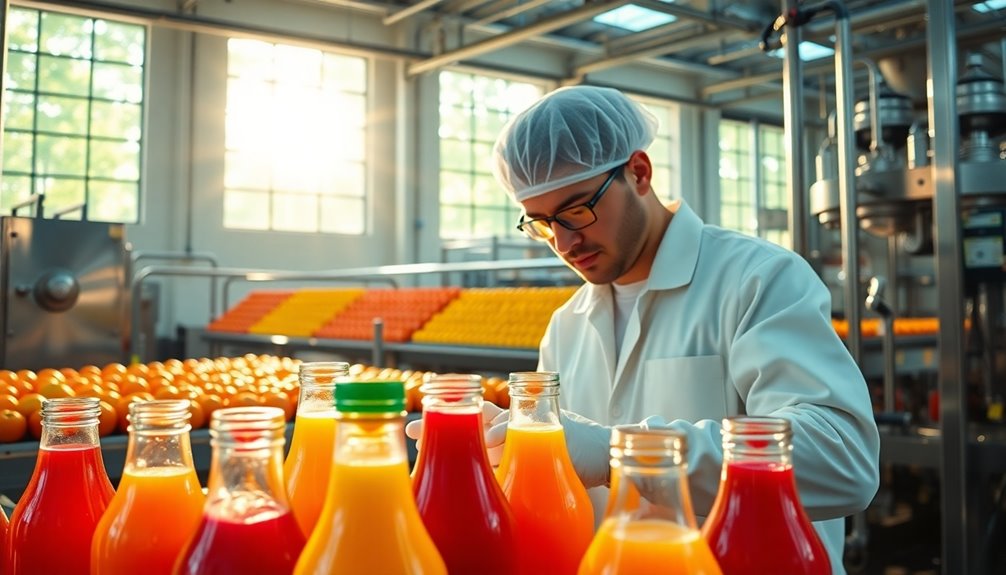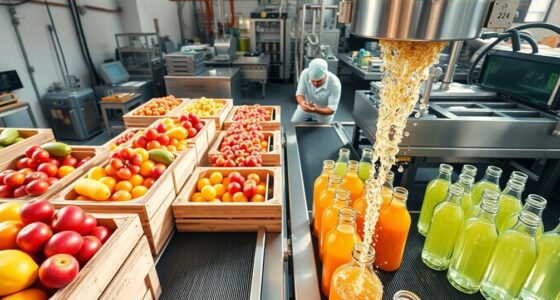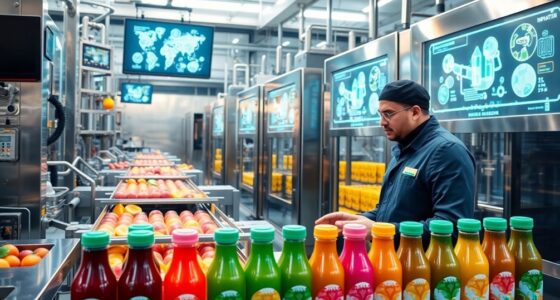Mastering quality control in juice manufacturing is all about ensuring safety, freshness, and exceptional quality in every bottle. You’ll want to monitor key parameters like acidity and sugar content, while implementing strict hygiene protocols throughout the production process. Regular inspections and sorting high-quality fruits play an essential role in preventing contamination and spoilage. To maintain your brand’s reputation, focus on these practices, and discover insider secrets that can elevate your juice quality even further. Additionally, investing in advanced technology for real-time monitoring can significantly enhance the juice quality manufacturing process, allowing for timely adjustments to maintain optimal standards. Training staff on the importance of these quality control measures not only promotes a culture of excellence but also empowers them to detect any deviations proactively. By continually refining these processes and staying updated with industry standards, you can ensure that every bottle reflects your commitment to quality.
Key Takeaways
- Maintain strict hygiene standards and regular sanitation of equipment to prevent microbial contamination in juice production.
- Implement continuous monitoring of acidity and sugar levels to ensure product quality and safety.
- Regularly inspect and sort raw materials to eliminate damaged or diseased fruits before processing.
- Utilize pasteurization techniques to eliminate harmful microbes while preserving juice freshness.
- Conduct routine audits of production and storage conditions to maintain optimal quality and compliance.
What Is Fruit Juice Quality Control?
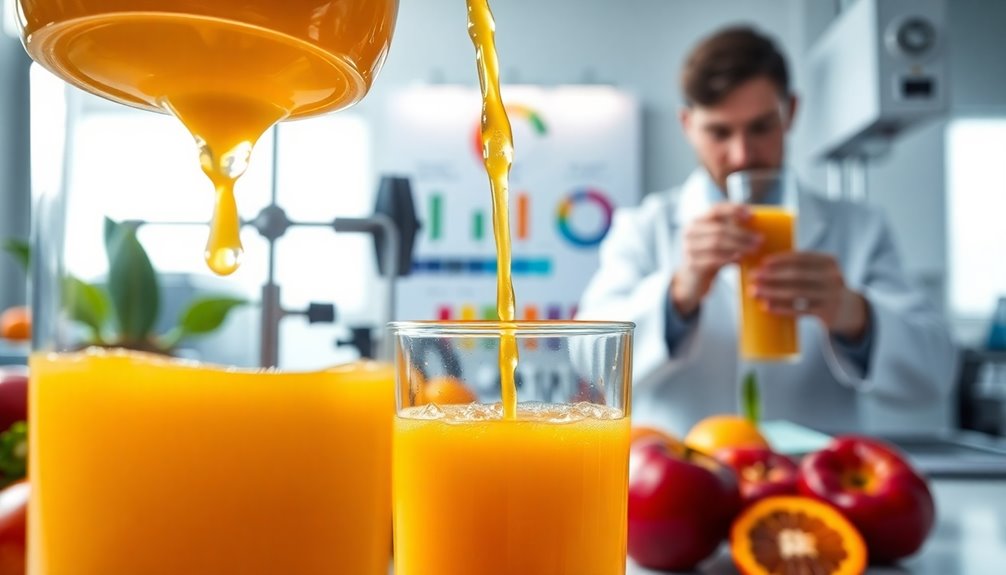
Fruit juice quality control is vital for guaranteeing that every bottle you produce meets safety and quality standards. This systematic process monitors key parameters like acidity, sugar content, and color consistency.
You need to focus on maintaining hygiene to minimize the risk of microbial contamination that can lead to health risks and spoilage. Regular audits and inspections are essential for compliance with regulatory requirements, helping you identify any deviations from established quality standards.
By implementing effective quality control measures, you not only enhance customer satisfaction but also strengthen your brand reputation. Additionally, understanding healthiest fruit juice varieties can guide your formulation processes to meet consumer preferences for nutritious options.
Ultimately, mastering quality control guarantees that your juice products remain consistent and safe, making a significant impact on your market share and customer loyalty.
Why Is Quality Control Important in Fruit Juice Production?
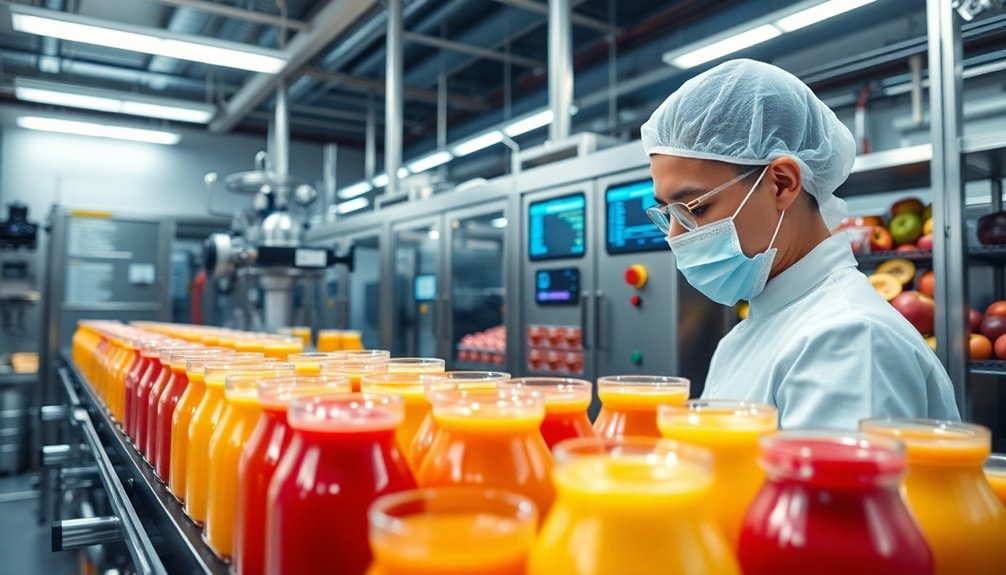
Quality control is vital in juice production, as it safeguards both the integrity of your product and the health of your consumers.
Implementing effective quality control measures is essential for several reasons:
- Guarantees food safety by preventing microbial contamination.
- Maintains consistency in taste and nutritional value.
- Enhances customer satisfaction and brand reputation.
- Monitors raw materials to eliminate defects and spoilage.
- Protects profitability by minimizing financial losses from recalls. Additionally, regular quality control checks on raw materials help ensure the freshest ingredients are used in production.
What Parameters Are Monitored in Fruit Juice Production?

In fruit juice production, you'll want to keep a close eye on several key parameters.
Monitoring acidity levels guarantees the right taste and prevents spoilage, while sugar content analysis helps meet consumer preferences for sweetness.
Additionally, microbial contamination testing is essential for securing product safety and extending shelf life.
Acidity Level Monitoring
While producing juice, monitoring acidity levels is essential for ensuring the final product meets taste and safety standards. The ideal pH typically ranges between 3.0 and 4.0, varying by fruit type.
Regular testing of acidity contributes to quality control, helping to inhibit the growth of harmful microorganisms and prevent spoilage.
Key parameters to monitor include:
- Desired pH range
- Effects of blending different juices
- Use of citric acid for adjustments
- Consistency in acidity levels
- Impact on shelf-life
Sugar Content Analysis
Sugar content analysis is a pivotal aspect of juice production that directly impacts flavor and consumer satisfaction. You'll typically measure sugar content in degrees Brix, which varies by fruit type. For natural fruit juices, Brix levels usually range from 10 to 15, indicating sweetness. Regular monitoring of sugar content is crucial to maintain product quality and comply with regulatory standards for nutrition labeling. Deviations can lead to consumer dissatisfaction, so using advanced technology like refractometers guarantees accurate measurements.
| Fruit Type | Ideal Brix Level | Impact on Flavor |
|---|---|---|
| Orange | 10-12 | Sweet and Tangy |
| Apple | 12-14 | Crisp and Sweet |
| Grape | 15-18 | Rich and Sweet |
Microbial Contamination Testing
Ensuring the safety of fruit juice requires vigilant microbial contamination testing, as harmful bacteria, yeast, and mold can jeopardize both quality and consumer health.
You need to focus on several key parameters to maintain safety and quality:
- Regular monitoring of raw fruits
- Swabbing processing equipment for pathogens
- Testing juice samples for viable microorganisms
- Enforcing stringent hygiene practices
- Implementing thorough cleaning protocols
How Is Quality Control Implemented in the Fruit Juice Process?
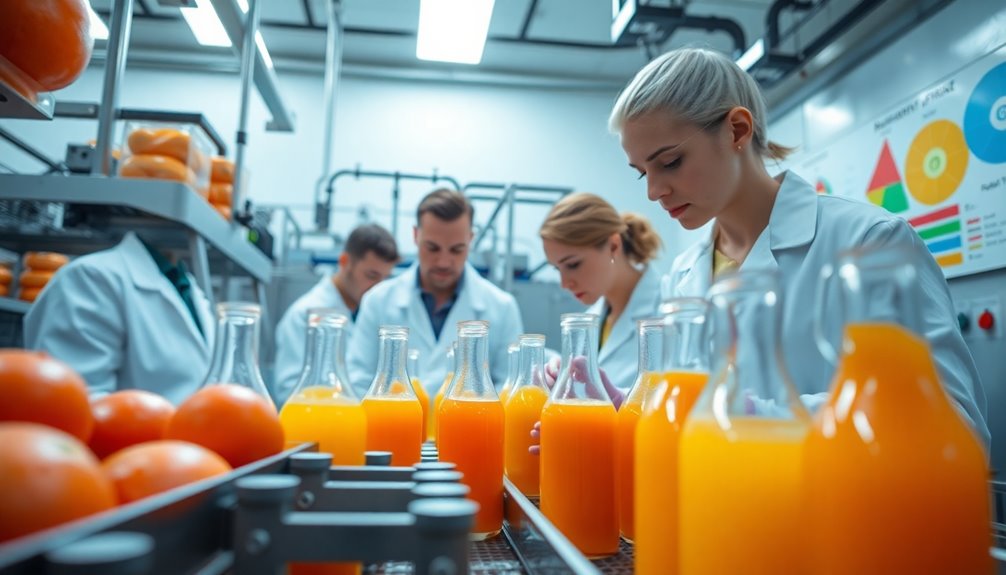
In the fruit juice process, you monitor key parameters like acidity and sugar content to guarantee quality and consistency.
You also enforce strict hygiene standards to prevent contamination from raw materials and equipment.
Monitoring Juice Parameters
Quality control in juice manufacturing hinges on meticulously monitoring key parameters throughout the production process.
You need to keep a close eye on specific factors to guarantee juice quality and adherence to compliance and quality standards.
Here are some critical parameters to track:
- Acidity levels (pH between 3.0 and 4.0)
- Sugar content (Brix)
- Microbial contamination
- Sorting of damaged or diseased fruits
- Regular inspections for contaminants: foreign
Ensuring Hygiene Standards
While maintaining high hygiene standards is essential for fruit juice production, it requires a thorough approach to prevent microbial contamination.
You need to establish rigorous cleaning protocols for both raw fruits and processing equipment. Start by washing fruits to remove dirt and pesticides, followed by sanitizing equipment to avoid cross-contamination.
Enforce personal hygiene practices for workers, like handwashing and wearing protective clothing, to minimize the risk of introducing contaminants into the juice.
Implement quality control protocols that include microbial testing and routine audits of hygiene practices throughout the production process.
Finally, comply with food safety regulations through systematic inspections and documentation, ensuring that hygiene standards are consistently met during fruit juice processing.
Your commitment to these practices guarantees product safety and quality.
What Are the Key Measures to Prevent Quality Loss in Fruit Juice?
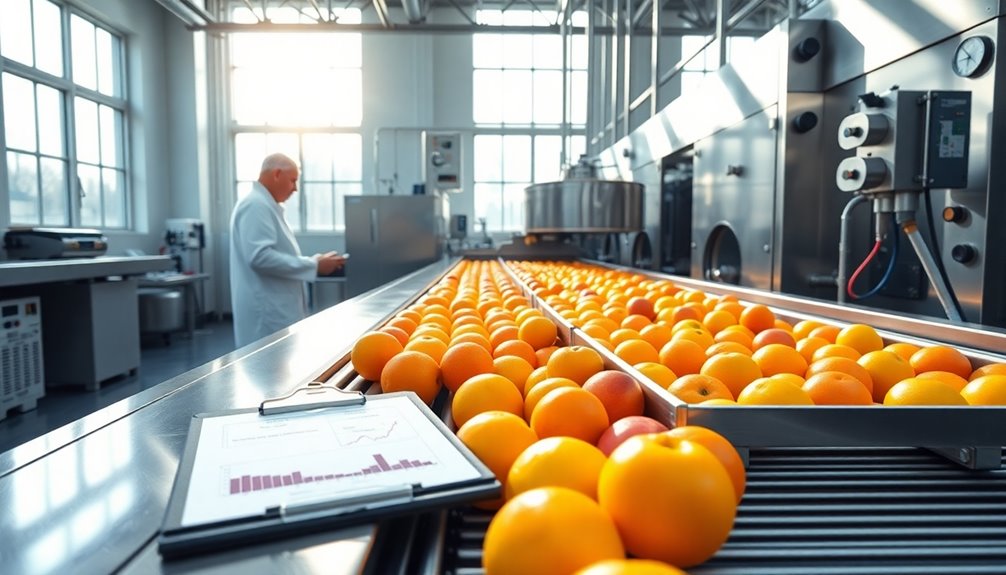
To guarantee your fruit juice maintains its quality, it's essential to focus on several key measures throughout the manufacturing process.
By implementing these strategies, you can greatly reduce the risk of quality loss and guarantee safety for consumers:
- Regularly monitor acidity levels, keeping pH between 3.0 and 4.0.
- Sort and inspect raw fruits to use only high-quality produce.
- Implement stringent sanitation practices to minimize contaminants.
- Utilize pasteurization and heat treatments to eliminate harmful microbes.
- Conduct consistent audits and inspections of production processes.
Why Is Hygiene Important in Fruit Juice Production?

Hygiene plays an essential role in fruit juice production, directly impacting both safety and quality. By ensuring proper hygiene, you eliminate dirt, pesticides, and microorganisms from fruits, providing a safe product for consumers.
Regular cleaning and sanitization of equipment are important to prevent microbial contamination, which can spoil the juice and pose health risks. You must also enforce strict personal hygiene practices among workers to minimize the introduction of contaminants during production.
Monitoring critical safety and hygiene parameters is essential for compliance with food safety regulations and maintaining product quality. Implementing robust hygiene protocols greatly reduces the likelihood of costly product recalls, safeguarding your brand reputation and delivering a high-quality juice that customers can trust.
How Is the Ph of Fruit Juice Monitored and Controlled?

How do you guarantee the pH of fruit juice stays within the ideal range?
For juice manufacturers, maintaining pH levels is essential for taste, color, and shelf-life.
Here's how you can monitor and control it effectively:
- Use pH meters for precise readings.
- Conduct regular testing throughout production.
- Adjust high pH levels using acidic fruits or citric acid.
- Train staff on quality control measures.
- Maintain records to track pH variations.
What Measures Are Implemented to Ensure the Ripeness and Freshness of Fruits and Vegetables?
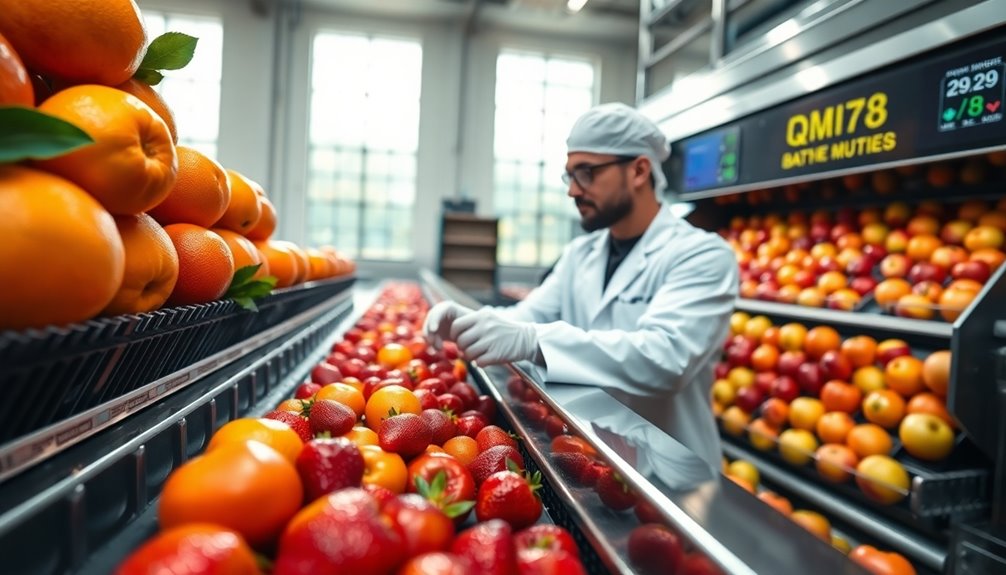
Maintaining the right pH levels in fruit juice sets the stage for quality, but it all starts with the fruits themselves.
To secure freshness and ripeness, careful selection of raw fruits at the ideal maturity stage is essential. This timing impacts not just the taste but also the nutritional value of your juice.
Gentle handling during harvesting and transportation minimizes damage, preserving their quality. Proper storage conditions, including temperature and humidity control, play a key role in maintaining freshness until processing.
Strict quality control measures during sorting guarantee that only high-quality, ripe fruits make it to the final product. Regular inspections of incoming raw fruits help eliminate any defective or spoiled items, ultimately protecting consumer health and enhancing your juice's overall quality.
Frequently Asked Questions
How Do You Manage Quality Control in Manufacturing?
To manage quality control in manufacturing, you need to implement systematic monitoring of key parameters like acidity and sugar content.
Use advanced technology, such as pH meters, for precise measurements. Enforce strict hygiene practices to prevent contamination and conduct regular audits to verify compliance with safety regulations.
Additionally, assess the quality of raw materials at harvest to guarantee that the final product meets your standards for taste and nutritional value.
What Is the Manufacturing Process of Juices?
Juice manufacturing dances through a series of steps. First, you select ripe fruits, ensuring their quality shines.
After gentle transport, you wash them, removing any unwanted dirt or chemicals.
Next, you sort and pulp, separating juice from solids.
You then pasteurize to eliminate harmful microbes, preserving flavor and safety.
Finally, you package the juice in sterile containers, implementing quality checks throughout to maintain that delicious integrity you aim for in every bottle.
What Is the Methodology of Fruit Juice?
The methodology of fruit juice production involves several key steps.
First, you'll harvest and sort the fruits, guaranteeing only the best make it through.
Next, you wash and pulp them, separating juice from solids.
pH levels are monitored closely, aiming for 3.0 to 4.0 for ideal flavor.
You also check sugar content to achieve the right sweetness.
Finally, microbial testing is essential to confirm the juice is safe for consumption.
How Is 100% Fruit Juice Made?
Making 100% fruit juice is as simple as capturing sunshine in a bottle!
You start by washing and sorting fresh, ripe fruits, then pulp them to extract the juice.
Monitoring pH levels guarantees the perfect balance of taste and shelf-life.
Pasteurization eliminates harmful bacteria, making it safe for you.
Finally, rigorous quality control checks acidity, sugar content, and color consistency to assure you get the purest juice possible.
Enjoy every sip!
Conclusion
As you dive deeper into the world of juice manufacturing, you'll uncover the hidden secrets of quality mastery that can elevate your products from ordinary to extraordinary. Imagine the taste, the freshness, and the satisfaction of knowing your juice meets the highest standards. But what happens when quality slips through the cracks? The answer might surprise you. Stay vigilant, keep learning, and guarantee your juice not only quenches thirst but also delights the senses—because every drop counts!
Cindy thoroughly researches juicing trends, techniques, and recipes to provide readers with practical advice and inspiration. Her writing style is accessible, engaging, and designed to make complex concepts easy to understand. Cindy’s dedication to promoting the advantages of juicing shines through her work, empowering readers to make positive changes in their lives through the simple act of juicing.

